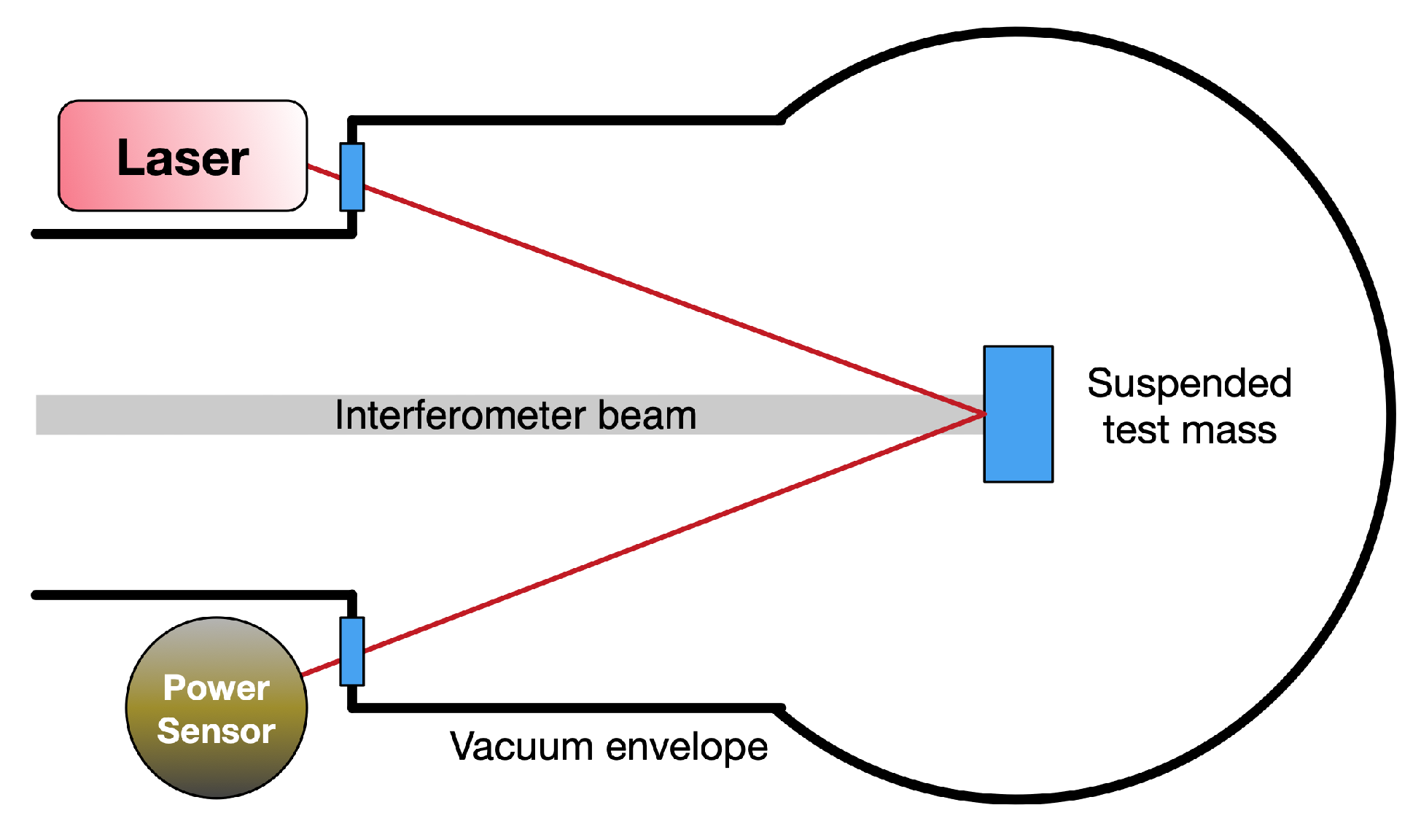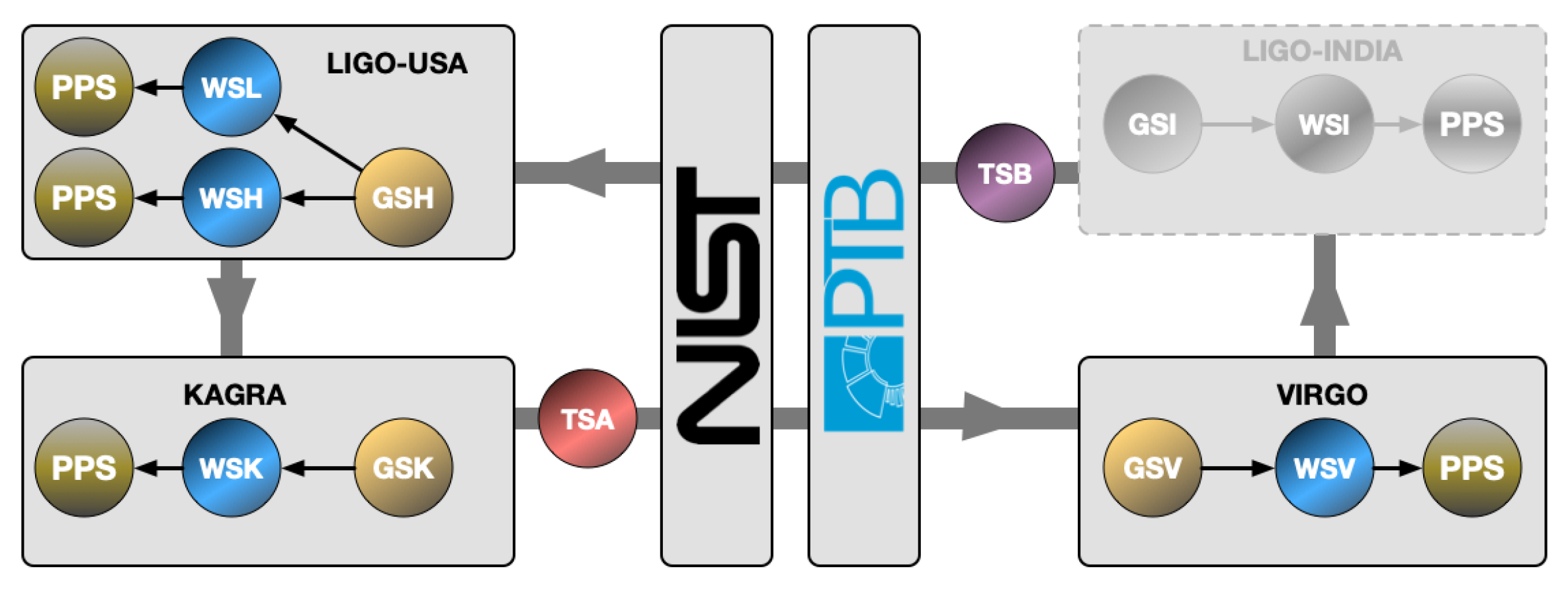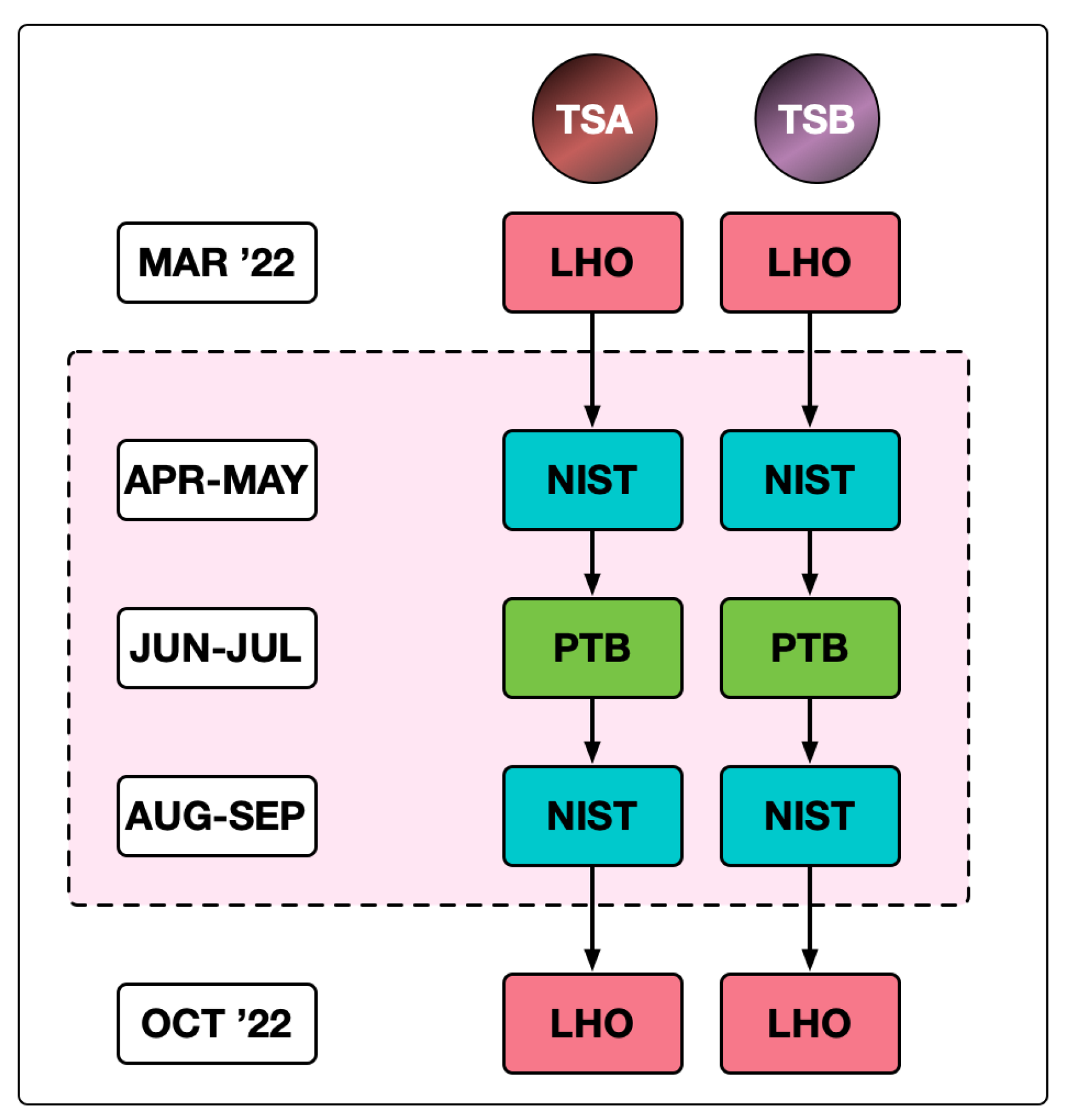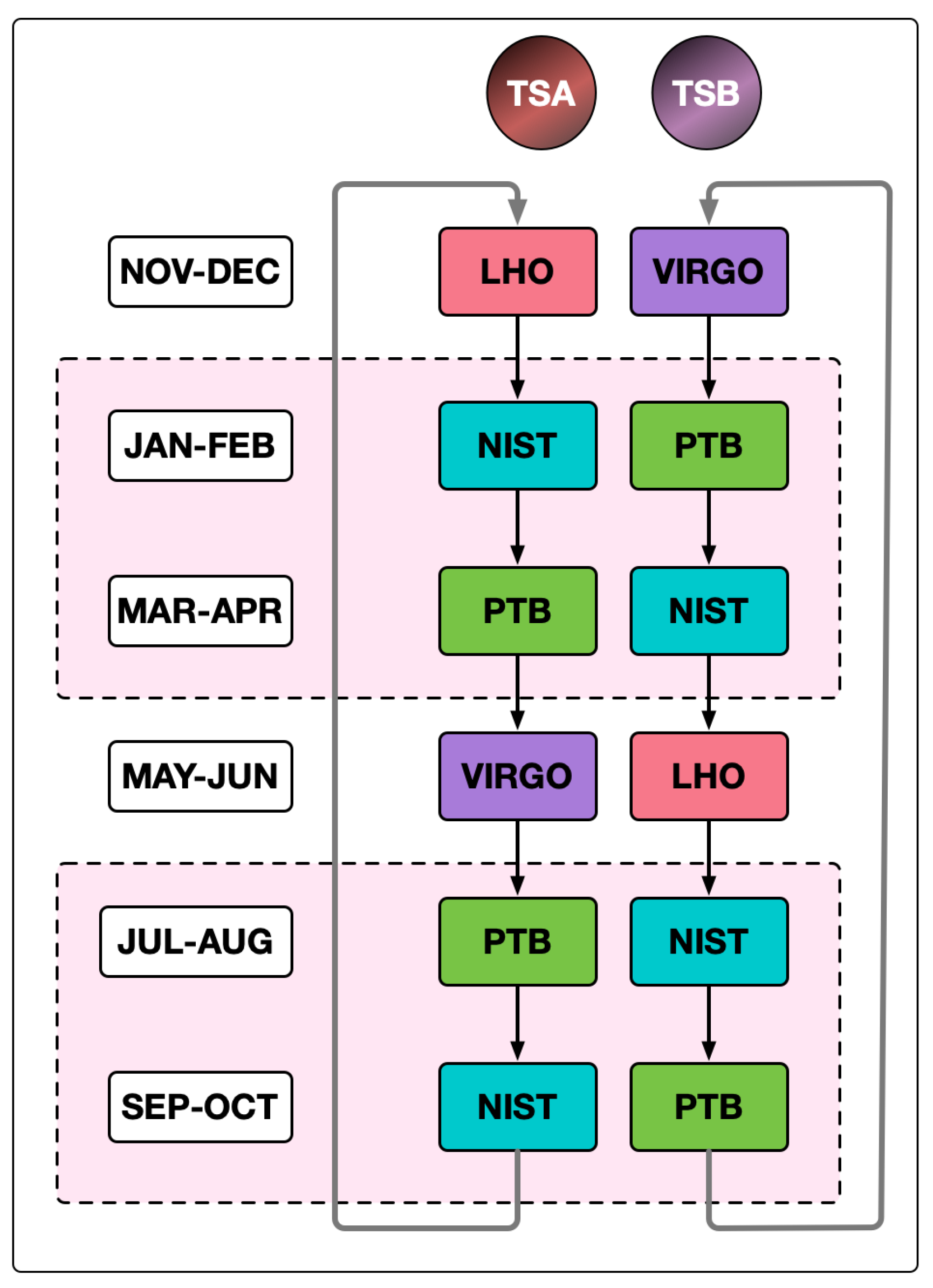Toward Calibration of the Global Network of Gravitational Wave Detectors with Sub-Percent Absolute and Relative Accuracy
Abstract
:1. Introduction
2. Evolution of Methods for Generating Calibrated Fiducial Displacements
3. Photon Calibrators: Development and the State of the Art
4. Laser Power Calibration for Photon Calibrators
5. Network Calibration for the O4 Observing Run and Beyond
6. Looking Ahead
Author Contributions
Funding
Acknowledgments
Conflicts of Interest
References
- Abbott, B.P.; Abbott, R.; Abbott, T.D.; Abernathy, M.R.; Acernese, F.; Ackley, K.; Adams, C.; Adams, T.; Addesso, P.; Adhikari, R.X.; et al. Observation of Gravitational Waves from a Binary Black Hole Merger. Phys. Rev. Lett. 2016, 116, 061102. [Google Scholar] [CrossRef] [PubMed]
- Abbott, B.P.; Abbott, R.; Abbott, T.; Abraham, S.; Acernese, F.; Ackley, K.; Adams, C.; Adhikari, R.X.; Adya, V.B.; Affeldt, C.; et al. GWTC-1: A Gravitational-Wave Transient Catalog of Compact Binary Mergers Observed by LIGO and Virgo during the First and Second Observing Runs. Phys. Rev. X 2019, 9, 031040. [Google Scholar] [CrossRef] [Green Version]
- Abbott, R.; Abbott, T.D.; Abraham, S.; Acernese, F.; Ackley, K.; Adams, A.; Adams, C.; Adhikari, R.X.; Adya, V.B.; Affeldt, C.; et al. GWTC-2: Compact Binary Coalescences Observed by LIGO and Virgo during the First Half of the Third Observing Run. Phys. Rev. X 2021, 11, 021053. [Google Scholar] [CrossRef]
- Abbott, R.; Abbott, T.D.; Acernese, F.; Ackley, K.; Adams, C.; Adhikari, N.; Adhikari, R.X.; Adya, V.B.; Affeldt, C.; Agarwal, D.; et al. GWTC-3: Compact Binary Coalescences Observed by LIGO and Virgo During the Second Part of the Third Observing Run. arXiv 2021, arXiv:gr-qc/2111.03606. [Google Scholar]
- Scientific, L.I.; Collaborations, V.; Abbott, B.P.; Abbott, R.; Abbott, T.D.; Abernathy, M.R.; Acernese, F.; Ackley, K.; Adams, C.; Adams, T.; et al. Tests of general relativity with GW150914. Phys. Rev. Lett. 2016, 116, 221101. [Google Scholar]
- Abbott, B.P.; Abbott, R.; Abbott, T.D.; Abraham, S.; Acernese, F.; Ackley, K.; Adams, C.; Adhikari, R.X.; Adya, V.B.; Affeldt, C.; et al. Tests of general relativity with the binary black hole signals from the LIGO-Virgo catalog GWTC-1. Phys. Rev. D 2019, 100, 104036. [Google Scholar] [CrossRef] [Green Version]
- Abbott, R.; Abbott, T.D.; Abraham, S.; Acernese, F.; Ackley, K.; Adams, A.; Adams, C.; Adhikari, R.X.; Adya, V.B.; Affeldt, C.; et al. Tests of general relativity with binary black holes from the second LIGO-Virgo gravitational-wave transient catalog. Phys. Rev. D 2021, 103, 122002. [Google Scholar] [CrossRef]
- Abbott, B.P.; Abbott, R.; Abbott, T.D.; Acernese, F.; Ackley, K.; Adams, C.; Adams, T.; Addesso, P.; Adhikari, R.X.; Adya, V.B.; et al. On the Progenitor of Binary Neutron Star Merger GW170817. Astrophys. J. Lett. 2017, 850, L40. [Google Scholar] [CrossRef]
- Abbott, B.P.; Abbott, R.; Abbott, T.D.; Acernese, F.; Ackley, K.; Adams, C.; Adams, T.; Addesso, P.; Adhikari, R.X.; Adya, V.B.; et al. Properties of the binary neutron star merger GW170817. Phys. Rev. X 2019, 9, 011001. [Google Scholar] [CrossRef] [Green Version]
- Abbott, B.P.; Abbott, R.; Abbott, T.D.; Acernese, F.; Ackley, K.; Adams, C.; Adams, T.; Addesso, P.; Adhikari, R.X.; Adya, V.B.; et al. Estimating the Contribution of Dynamical Ejecta in the Kilonova Associated with GW170817. Astrophys. J. Lett. 2017, 850, L39. [Google Scholar] [CrossRef]
- Albert, A.; André, M.; Anghinolfi, M.; Ardid, M.; Aubert, J.J.; Aublin, J.; Avgitas, T.; Baret, B.; Barrios-Martí, J.; Basa, S.; et al. Search for High-energy Neutrinos from Binary Neutron Star Merger GW170817 with ANTARES, IceCube, and the Pierre Auger Observatory. Astrophys. J. Lett. 2017, 850, L35. [Google Scholar] [CrossRef]
- Abbott, B.P.; Abbott, R.; Abbott, T.D.; Acernese, F.; Ackley, K.; Adams, C.; Adams, T.; Addesso, P.; Adhikari, R.X.; Adya, V.B.; et al. GW170817: Measurements of Neutron Star Radii and Equation of State. Phys. Rev. Lett. 2018, 121, 161101. [Google Scholar] [CrossRef] [PubMed] [Green Version]
- Abbott, B.P.; Abbott, R.; Abbott, T.D.; Acernese, F.; Ackley, K.; Adams, C.; Adams, T.; Addesso, P.; Adhikari, R.X.; Adya, V.B.; et al. A gravitational-wave standard siren measurement of the Hubble constant. Nature 2017, 551, 85–88. [Google Scholar]
- Abbott, B.P.; Abbott, R.; Abbott, T.D.; Acernese, F.; Ackley, K.; Adams, C.; Adams, T.; Addesso, P.; Adhikari, R.X.; Adya, V.B.; et al. Gravitational Waves and Gamma-rays from a Binary Neutron Star Merger: GW170817 and GRB 170817A. Astrophys. J. Lett 2017, 848, L13. [Google Scholar] [CrossRef]
- Abbott, B.P.; Abbott, R.; Abbott, T.D.; Abraham, S.; Acernese, F.; Ackley, K.; Adams, C.; Adya, V.B.; Affeldt, C.; Agathos, M.; et al. Prospects for Observing and Localizing Gravitational-Wave Transients with Advanced LIGO, Advanced Virgo and KAGRA. Living Rev. Relativ 2020, 23, 3. [Google Scholar] [CrossRef]
- Lindblom, L. Optimal Calibration Accuracy for Gravitational Wave Detectors. Phys. Rev. 2009, D80, 042005. [Google Scholar] [CrossRef] [Green Version]
- Aasi, J.; Abbott, B.P.; Abbott, R.; Abbott, T.; Abernathy, M.R.; Ackley, K.; Adams, C.; Adams, T.; Addesso, P.; Adhikari, R.X.; et al. Advanced LIGO. Class. Quantum Grav. 2015, 32, 074001. [Google Scholar]
- Acernese, F.A.; Agathos, M.; Agatsuma, K.; Aisa, D.; Allemandou, N.; Allocca, A.; Amarni, J.; Astone, P.; Balestri, G.; Ballardin, G.; et al. Advanced Virgo: A second-generation interferometric gravitational wave detector. Class. Quantum Grav. 2014, 32, 024001. [Google Scholar] [CrossRef] [Green Version]
- Akutsu, T.; Ando, M.; Arai, K.; Arai, Y.; Araki, S.; Araya, A.; Aritomi, N.; Aso, Y.; Bae, S.; Bae, Y.; et al. Overview of KAGRA: Detector design and construction history. Prog. Theor. Exp. Phys. 2021, 2021, 05A101. [Google Scholar] [CrossRef]
- Sun, L.; Goetz, E.; Kissel, J.S.; Betzwieser, J.; Karki, S.; Viets, A.; Wade, M.; Bhattacharjee, D.; Bossilkov, V.; Covas, P.B.; et al. Characterization of systematic error in Advanced LIGO calibration. Class. Quantum Grav. 2020, 29, 225008. [Google Scholar] [CrossRef]
- Bhattacharjee, D.; Lecoeuche, Y.; Karki, S.; Betzwieser, J.; Bossilkov, V.; Kandhasamy, S.; Payne, E.; Savage, R.L. Fiducial displacements with improved accuracy for the global network of gravitational wave detectors. Class. Quantum Grav. 2020, 38, 015009. [Google Scholar] [CrossRef]
- Adhikari, R.; González, G.; Landry, M.; O’Reilly, B. Calibration of the LIGO detectors for the First LIGO Science Run. Class. Quantum Grav. 2003, 20, 903–914. [Google Scholar] [CrossRef]
- Goetz, E.; Savage, R.L.; Garofoli, J.; Gonzalez, G.; Hirose, E.; Kalmus, P.; Kawabe, K.; Kissel, J.; Landry, M.; O’Reilly, B.; et al. Accurate calibration of test mass displacement in the LIGO interferometers. Class. Quantum Grav. 2010, 27, 084024. [Google Scholar] [CrossRef]
- Accadia, T.; Acernese, F.; Antonucci, F.; Astone, P.; Ballardin, G.; Barone, F.; Barsuglia, M.; Basti, A.; Bauer, T.S.; Beker, M.G.; et al. Calibration and sensitivity of the Virgo detector during its second science run. Class. Quantum Grav. 2010, 28, 025005. [Google Scholar] [CrossRef]
- Accadia, T.; Acernese, F.; Antonucci, F.; Astone, P.; Ballardin, G.; Barone, F.; Barsuglia, M.; Basti, A.; Bauer, T.S.; Beker, M.G.; et al. Calibration of advanced Virgo and reconstruction of the gravitational wave signal h(t) during the observing run O2. Class. Quantum Grav. 2018, 35, 205004. [Google Scholar]
- Goetz, E.; Savage, R.L. Calibration of the LIGO displacement actuators via laser frequency modulation. Class. Quantum Grav. 2010, 27, 215001. [Google Scholar] [CrossRef]
- Rakhmanov, M.; Savage, R.L.; Reitze, D.; Tanner, D.B. Dynamic resonance of light in Fabry-Perot cavities. Phys. Lett. A 2002, 305, 239–244. [Google Scholar] [CrossRef] [Green Version]
- Estevez, D.; Lieunard, B.; Marion, F.; Mours, B.; Roll, L.; Verkindt, D. First Tests of a Newtonian Calibrator on an Interferometric Gravitational Wave Detector. Class. Quantum Grav. 2018, 35, 235009. [Google Scholar] [CrossRef] [Green Version]
- Estevez, D.; Mours, B.; Pradier, T. Newtonian calibrator tests during the Virgo O3 data taking. Class. Quantum Grav. 2021, 38, 075012. [Google Scholar] [CrossRef]
- Inoue, Y.; Haino, S.; Kanda, N.; Ogawa, Y.; Suzuki, T.; Tomaru, T.; Yamanmoto, T.; Yokozawa, T. Improving the absolute accuracy of the gravitational wave detectors by combining the photon pressure and gravity field calibrators. Phys. Rev. 2018, D98, 022005. [Google Scholar] [CrossRef] [Green Version]
- Ross, M.P.; Mistry, T.; Datrier, L.; Kissel, J.; Venkateswara, K.; Weller, C.; Kumar, K.; Hagedorn, C.; Adelberger, E.; Lee, J.; et al. Initial results from the LIGO Newtonian calibrator. Phys. Rev. D 2021, 104, 082006. [Google Scholar] [CrossRef]
- Forward, R.L.; Miller, L.R. Generation and Detection of Dynamic Gravitational-Gradient Fields. J. Appl. Phys. 1967, 38, 512–518. [Google Scholar] [CrossRef]
- Sinsky, J.; Weber, J. New Source for Dynamical Gravitational Fields. Phys. Rev. Lett. 1967, 18, 795–797. [Google Scholar] [CrossRef]
- Sinsky, J.A. Generation and Detection of Dynamic Newtonian Gravitational Fields at 1660 cps. Phys. Rev. 1968, 167, 1145–1151. [Google Scholar] [CrossRef]
- Hirakawa, H.; Tsubono, K.; Oide, K. Dynamical test of the law of gravitation. Nature 2018, 283, 184–185. [Google Scholar] [CrossRef]
- Suzuki, T.; Tsubono, K.; Kuroda, K.; Hirakawa, H. Calibration of Gravitational Radiation Antenna by Dynamic Newton Field. Jpn. J. Appl. Phys. 1981, 20, L498–L500. [Google Scholar] [CrossRef]
- Ogawa, Y.; Tsubono, K.; Hirakawa, H. Experimental test of the law of gravitation. Phys. Rev. D 1982, 26, 729–734. [Google Scholar] [CrossRef]
- Matone, L.; Raffai, P.; Márka, S.; Grossman, R.; Kalmus, P.; Márka, Z.; Rollins, J.; Sannibale, V. Benefits of artificially generated gravity gradients for interferometric gravitational-wave detectors. Class. Quantum Grav. 2007, 24, 2217–2229. [Google Scholar] [CrossRef] [Green Version]
- Clubley, D.A.; Newton, G.P.; Skeldon, K.D.; Hough, J. Calibration of the Glasgow 10 m prototype laser interferometric gravitational wave detector using photon pressure. Phys. Lett. A 2001, 283, 85. [Google Scholar] [CrossRef]
- Mossavi, K.; Hewitson, M.; Hild, S.; Seifert, F.; Weil, U.; Smith, J.R.; Lück, H.; Grote, H.; Willke, B.; Danzmann, K. A photon pressure calibrator for the GEO600 gravitational wave detector. Phys. Lett. A 2006, 353, 1. [Google Scholar] [CrossRef] [Green Version]
- Bruursema, J. Calibration of the LIGO Interferometer Using the Recoil of Photons; T030266; LIGO Document Control Center: Washington, DC, USA, 2003. [Google Scholar]
- Sigg, D. Strain Calibration in LIGO; T970101; LIGO Document Control Center: Washington, DC, USA, 1997. [Google Scholar]
- Goetz, E.; Kalmus, P.; Erickson, S.; Savage, R.L.; Gonzalez, G.; Kawabe, K.; Landry, M.; Marka, S.; O’Reilly, B.; Riles, K.; et al. Precise calibration of LIGO test mass actuators using photon radiation pressure. Class. Quantum Grav. 2009, 26, 245011. [Google Scholar] [CrossRef] [Green Version]
- Karki, S.; Tuyenbayev, D.; Kandhasamy, S.; Abbott, B.P.; Abbott, T.D.; Anders, E.H.; Berliner, J.; Betzwieser, J.; Cahillane, C.; Canete, L.; et al. The Advanced LIGO photon calibrators. Rev. Sci. Instrum. 2016, 87, 114503. [Google Scholar] [CrossRef] [PubMed]
- Accadia, T.; Acernese, F.; Agathos, M.; Allocca, A.; Astone, P.; Ballardin, G.; Barone, F.; Barsuglia, M.; Basti, A.; Bauer, T.S.; et al. Reconstruction of the gravitational wave signal h(t) during the Virgo science runs and independent validation with a photon calibrator. Class. Quantum Grav. 2014, 31, 165013. [Google Scholar] [CrossRef] [Green Version]
- Estevez, D.; Lagabbe, P.; Masserot, A.; Roll, L.; Seglar-Arroyo, M.; Verkindt, D. The Advanced Virgo photon calibrators. Class. Quantum Grav. 2021, 38, 075007. [Google Scholar] [CrossRef]
- Akutsu, T.; Ando, M.; Arai, K.; Arai, Y.; Araki, S.; Araya, A.; Aritomi, N.; Asada, H.; Aso, Y.; Bae, S.; et al. Overview of KAGRA: Calibration, detector characterization, physical environmental monitors, and the geophysics interferometer. Prog. Theor. Exp. Phys 2021, 2021, 05A102. [Google Scholar] [CrossRef]
- Brooks, A.F.; Vajente, G.; Yamamoto, H.; Abbott, R.; Adams, C.; Adhikari, R.X.; Ananyeva, A.; Appert, S.; Arai, K.; Areeda, J.S.; et al. Point absorbers in Advanced LIGO. Appl. Opt. 2021, 60, 4047–4063. [Google Scholar] [CrossRef]
- Schofield, R. PEM Update; G1701613; LIGO Document Control Center: Washington, DC, USA, 2007. [Google Scholar]
- Goetz, E. Gravitational Wave Studies: Detector Calibration and an All-Sky Search for Spinning Neutron Stars in Binary Systems. Ph.D. Thesis, University of Michigan, Arbor, MI, USA, 2010. [Google Scholar]
- Hild, S.; Brinkmann, M.; Danzmann, K.; Grote, H.; Hewitson, M.; Hough, J.; Lück, H.; Martin, I.; Mossavi, K.; Rainer, N.; et al. Photon Pressure Induced Test Mass Deformation in Gravitational-Wave Detectors. Class. Quantum Grav. 2007, 24, 5681–5688. [Google Scholar] [CrossRef]
- Canete, L. Optical Follower Servo Design for the Calibration of a Gravitational Wave Detector; T130442; LIGO Document Control Center: Washington, DC, USA, 2013. [Google Scholar]
- Photon Calibrator Gold Standard NIST Calibration; T1900097; LIGO Document Control Center: Washington, DC, USA, 2018.
- Kück, S. Final report on EUROMET comparison EUROMET.PR-S2 (Project No. 156): Responsivity of detectors for radiant power of lasers. Metrologia 2010, 47, 02003. [Google Scholar] [CrossRef]
- Tomaru, T. Private Communication; National Observatory of Japan: Tokyo, Japan, 2016. [Google Scholar]
- Lehman, J. NIST Workshop 2019 Executive Summary; LIGO-L1900166; LIGO Document Control Center: Washington, DC, USA, 2019. [Google Scholar]
- Spidell, M.; Lehman, J.; López, M.; Lecher, H.; Kück, S.; Bhattacharjee, D.; Lecoeuche, Y.; Savage, R. A bilateral comparison of NIST and PTB laser power standards for scale realization confidence by gravitational wave observatories. Metrologia 2021, 58, 055011. [Google Scholar] [CrossRef]
- Lecoeuche, Y. Performance Review of Pcal Power Standard Detector Spacers; T12000714; LIGO Document Control Center: Washington, DC, USA, 2020. [Google Scholar]
- Vaskuri, A.K.; Stephens, M.S.; Tomlin, N.A.; Spidell, M.T.; Yung, C.S.; Walowitz, A.J.; Straatsma, C.; Harber, D.; Lehman, J.H. High-accuracy room temperature planar absolute radiometer based on vertically aligned carbon nanotubes. Opt. Express 2021, 29, 22533–22552. [Google Scholar] [CrossRef]
- Essick, R.; Holz, D.E. Calibrating gravitational-wave detectors with GW170817. Class. Quantum Grav. 2019, 36, 125002. [Google Scholar] [CrossRef]
- Mukherjee, S.; Wandelt, B.D.; Nissanke, S.M.; Silvestri, A. Accurate precision cosmology with redshift unknown gravitational wave sources. Phys. Rev. D 2021, 103, 043520. [Google Scholar] [CrossRef]
- Pitkin, M.; Messenger, C.; Wright, L. Astrophysical calibration of gravitational-wave detectors. Phys. Rev. 2016, D93, 062002. [Google Scholar] [CrossRef] [Green Version]
- Schutz, B.F.; Sathyaprakash, B.S. Self-calibration of Networks of Gravitational Wave Detectors. arXiv 2020, arXiv:2009.10212. [Google Scholar]
- Sun, L.; Goetz, E.; Kissel, J.S.; Betzwieser, J.; Karki, S.; Bhattacharjee, D.; Covas, P.B.; Datrier, L.E.; Kandhasamy, S.; Lecoeuche, Y.K.; et al. Characterization of systematic error in Advanced LIGO calibration in the second half of O3. arXiv 2021, arXiv:astro-ph.IM/2107.00129. [Google Scholar]







| ETM Reflected Power | Fiducial Displacements | ||
|---|---|---|---|
| LIGO | Virgo | LIGO | Virgo |
| 0.34% | 1.24% | 0.41% | 1.40% |
Publisher’s Note: MDPI stays neutral with regard to jurisdictional claims in published maps and institutional affiliations. |
© 2022 by the authors. Licensee MDPI, Basel, Switzerland. This article is an open access article distributed under the terms and conditions of the Creative Commons Attribution (CC BY) license (https://creativecommons.org/licenses/by/4.0/).
Share and Cite
Karki, S.; Bhattacharjee, D.; Savage, R.L. Toward Calibration of the Global Network of Gravitational Wave Detectors with Sub-Percent Absolute and Relative Accuracy. Galaxies 2022, 10, 42. https://doi.org/10.3390/galaxies10020042
Karki S, Bhattacharjee D, Savage RL. Toward Calibration of the Global Network of Gravitational Wave Detectors with Sub-Percent Absolute and Relative Accuracy. Galaxies. 2022; 10(2):42. https://doi.org/10.3390/galaxies10020042
Chicago/Turabian StyleKarki, Sudarshan, Dripta Bhattacharjee, and Richard L. Savage. 2022. "Toward Calibration of the Global Network of Gravitational Wave Detectors with Sub-Percent Absolute and Relative Accuracy" Galaxies 10, no. 2: 42. https://doi.org/10.3390/galaxies10020042
APA StyleKarki, S., Bhattacharjee, D., & Savage, R. L. (2022). Toward Calibration of the Global Network of Gravitational Wave Detectors with Sub-Percent Absolute and Relative Accuracy. Galaxies, 10(2), 42. https://doi.org/10.3390/galaxies10020042






